by Wine Owners
Posted on 2022-10-13
Today the wine part of the Wine Owners team, as opposed to the tech team who provide our best-in-class software solutions, tasted wines from one of the great sub-sections of the Union of Grand Crus; it is called the Bordeaux Grands Crus Classés - to avoid confusion!
Wines offered came from 2018-2021 vintages. What was abundantly clear was that 2019 has reconfirmed itself as the best of modern vintages. Also, 2018 is not for the faint hearted, especially Montrose, and also that second wines offer a lot of drinking pleasure at a diddly squat fraction of grand vin prices. La Dame de Montrose excelled, as did La Croix de Canon. The unpronounceable Chateau d’Aiguilhe from the Cotes de Castillon performed well, as usual (apart from the ’21), and at £150 per 12 in bond for the 2019 is remarkable value. Chateau Canon reinforced its ‘polished’ status and was probably the most consistent.
There were some volatile samples of ‘21s, which we imagine not to be representative.
To my mind, the question is not what to buy but when to buy, if you haven’t already - 2019 should be in everybody’s cellars.
Chateaux represented:
Smith Haut Lafitte
Gazin
Vignobles Comtes Von Niepperg - d’Aiguilhe, Clos de l’Oratoire, Canon La Gaffeliere, La Mondotte
Canon
Rauzan Segla
Branaire Ducru
Pontet Canet
Montrose
Guiraud
For enormous pleasure and for a twist on sweet wines, readers should definitely embrace the current trend of lighter wines from the region. Fresher and less sweet wines from Sauternes were particularly well represented by the second wines of Chateau Guiraud and these will make a very stylish aperitif. The dry whites of Smith Haut Lafitte were superb, and are so often overlooked for more obvious alternatives, Burgundy normally, as are most dry white Bordeaux wines - in the U.K. at least.
Miles Davis October 11th 2022
by Wine Owners
Posted on 2022-03-14

Nebbiolo Day returned to London on 3rd March, showcasing Piedmontese passion and prowess in all things Nebbiolo.
I used it as an opportunity to taste taste taste, side by side a variety of producers, crus and vintages and delve right down into why Nebbiolo is deservedly enjoying more and more attention from collectors. There was not enough time or oral capacity to taste everything on offer, so I focused on Barolo and Barbaresco producers and may have missed some gems from Alto Piemonte and Valtellina.
My main 3 takeaways were as follows:-
1) Langhe Nebbiolo should feature in everyone's home cellar for immediate consumption. Pretty much universally under £20 per bottle and in some cases difficult to separate from regular Barolo. GD Vajra, Diego Morra, Domenic Clerico and of course GB Burlotto 2020’s all stood out as high class efforts, as did Vietti 2019 (possibly because the grapes are all declassified Barolo….)
2) 2016 was something special. The vast majority of wines on show were from 2018, and the quality for the most part was high (exceptional in many cases) but 2016 has that something extra. The 2016’s on show simply just shone! .... do not miss and showed Nebbiolo at its absolute pinnacle. Giovanni Sordo Rocche di Castiglione, Brezza Bricco Sarmassa, Diego Morra Monvigliero were the highlights and still very much in their juvenile state. They are still cheap for what they offer!
3) Flagship wines generally lived up to the hype. It may sound obvious, but when you taste through a range it is always reassuring when the top name (and most expensive) delivers the goods, and in 2018 Piedmont, they do. Tasting notes like “Jackpot” appear in my notes by Paolo Scavnio’s Bric del Fiasc 2018, Brovia Ca Mia and pretty much everything on show by Pio Cesare (increasingly excited with more exclamation marks as you move up the range).
Finally, a special mention to for ArnaldoRivera, the largest cooperative of growers who have been producing consistently high quality wines in recent years, and whose “Undicicomuni” now boasts a selected blend of 21 plots (up from 16 when I last tasted pre pandemic). I like to think of it as NV champagne and a delight to drink. The single vineyard expressions on show were also stunning, both Rocche dell’Annunziata and Villero 2018’s..very exciting times for the group.
Thank you to Hunt and Speller for organising a well attended and vibrant event, I can’t wait for next year.
And Miles would like to add: there are still many 16s available at initial offer price, this vintage was EPIC and should be in everyone's cellar. Covid helped keep prices down… please load up, you will not be disappointed…. promise!
Luke MacWilliam
March 2022
07375 594 196
by Wine Owners
Posted on 2021-07-11
Will Cheval Blanc and Ausone no longer be Grand Cru Classé ‘A’ as from the 2021 vintage?
If so, it won’t be because of the Commission de Classement. The closing of the Saint-Emilion classification applications took place on June 30 and neither Cheval Blanc nor Ausone returned their copies.
Unlike the left bank classification system of 1855 that is pretty much immutable (with the exception of Mouton’s promotion to Premier Cru in 1973), the St Emilion classification is reviewed approximately once every 10 years, permitting a periodic revaluation of quality and performance. It’s not all been plain sailing; the 2006 reclassification was plagued by accusations of impropriety and was eventually annulled. Consequently, tastings conducted for the 2012 reclassification were outsourced to independent groups from across France to rehabilitate the process.
Cheval Blanc and Ausone, the first St Emilion producers to be awarded Classé A classification in 1954 when it was created, are effectively leaving the classification system.
The Classé A incumbents evidently concluded that the system is no longer sufficiently discriminating to reflect the ranking of their respective properties compared to their peers.
This bombshell threatens to undermine the kudos and financial benefits of promotion to Classé A, and in turn the market pricing potential of those that are elevated. Not to mention it raises questions of the credibility of the St Emilion classification system more broadly.
So what does the two colossus’s departure say about the process of decennial review? How does this reflect on the composition and process of the Commission de Classement?
Is Grand Cru Classé A about to lose its lustre; devalued by ambitious properties busy erecting glitzy edifices? Concrete and stone, some say, matter more than they ought to compared to the brilliance of the wines and their track record.
Or, is Classé A promotion a reflection of the qualitative transformation we see taking place in St Emilion - given the strongly weighted preconditions of a sustained track record of exceptional results and market recognition - and therefore are not elevations thoroughly deserved?
Let’s see what happens over the coming weeks. Can Cheval Blanc and Ausone be courted back into the fold, or is their departure (by omission of submission) a fait accompli? Assuming the latter, perhaps we'll see more promotions next year than we might have otherwise. What effect this all has economically on those producers who attain Classé A classification is now more uncertain than ever.
by Wine Owners
Posted on 2021-06-30
As mentioned in our recent and well received offer of the incredibly well priced Montepeloso Eneo 2010 (there are a few left), we promised a closer look into the relative value of Italian wines. I know I have been banging on about Italy for quite a while now but there is every reason for it – there is some terrific value to be had, and so on will I bang!
The facts are that there are only a handful of Italian wines that trade at, what we are going to call here, ‘silly money’ compared to vast swathes of wines from their rather posher neighbour - namely La Belle France. It is true that the same can be said for Spain, and for most of the New World. The U.S. is an exception, as like France, it has many an offering at ‘silly money’. But for my pound, I say sweepingly, these regions do not offer such a vast variety of quality wines that appeal in quite the same way (I should qualify at this point I am really talking about top quality red wines).
What Italy offers, unlike everywhere else, is a multitude of wines at relatively affordable prices with absolutely massive ratings. There are two variables here, the prices and the ratings; the simplest explanation for the comparatively lower pricing is that Italian wines have not yet been recognised, and accordingly priced, as truly international brands. Put another way, Asia has not got to grips with it yet. Other than a few ‘Super Tuscans’ and the top labels from the likes of Giacomo Conterno, Bruno Giacosa and Gaja from Piedmont, very little starts life close to £100 a bottle. There have been half a dozen EP releases every day last week from Bordeaux that qualify for that prize! In Burgundy a hefty percentage of premier crus start there and for some more sought-after growers, your £100 only buys you a taste of a lowly village wine.
The ratings are, rather obviously, dished out by the critics. It is worth remembering that each region is scored on its merits in a peer group fashion. The wines, as are the vintages, are reviewed in the context of that individual region or vintage. What has happened, however, is that tones have been set for different areas which do seem to vary from each other. Burgundy, for example, tends to harbour rather conservative scoring where anything over 95 is a massive achievement. Prices for these trophies are also massive. It is different in Italy. There are countless Brunelli with huge scores and even people in the trade ask, ‘how come there are so many 100 pointers we’ve never heard of’?
A possible explanation is that the bar has been set so high, and for so long, by the likes of DRC and Rousseau that a mere premier cru from someone like Dujac or Roumier is only worthy of 90/91 points. So, perhaps a cleaner canvas for the critics to assess has led to some more generous brushstrokes? Or perhaps it is a more generational thing; France has long been understood, consumed, and pontificated upon by the old guard, who might not quite understand the Italian way? An old friend of mine, an experienced wine merchant recently said to me “I don’t really get Italian wine” (Burgundy and Sauternes are more his bag!) and then confused me further by saying “except I couldn’t possibly eat Italian food without Italian wine”. I understand exactly what he means with the latter statement (but not the first), and this goes from pizza level all the way to Piazza Duomo, a three star Michelin in Alba – quite good by the way! Either way, some of the scores in recent times and particularly for the amazing ’16 vintage, in all of Italy, and the ’15 vintage in Tuscany, have drawn truly flamboyant landscapes from the young masters – and for not many Lira either!
The other thing to remember is that the critics live and die by their reputations, so if they are going to award high nineties or even the magical triple digits, you know the wines are going to be very good indeed – within the context of their peer group.
Obviously, we would love to hear from you to discuss the opportunities further and there will be offers to follow based on this theme. In the meantime, you may want to engage with the ‘Advanced Search’ button or take in some of these names which spring to mind:
Piedmont: Alessandria, Cavallotto, Grasso, Sandrone, Scavino, Vajra
Tuscany: Fontodi, Fuligni, Grattamacco, Il Poggione, Isole e Olena, Pertimali, Montepeloso
Ciao for now! Miles 07798 732 543
by Wine Owners
Posted on 2020-12-04
Wine Owners is the market-leading collection management platform that provides instant valuations and connects you with a peer to peer trading exchange.
Today, we're very pleased to announce that our collection management platform just got even better - and now includes a fabulous new home cellar management capability.
Imagine knowing exactly where each bottle is stored down to a hole in a rack, and being able to effortlessly move cases from a stack in the corner into bins or racks. Home cellars constantly change and this new release helps make organising them a joy.
Easily catalogue and organise wines at home.
Create new racks, bins and mixed cases
Move or add wines easily to your home cellar.
Save time by copying wines.
And create and update cellar references.
All this while getting the same high quality pricing data from our referential database.
If you want to start managing your home cellar, sign in to your account or create an account if you're not yet a member of Wine Owners.
by Wine Owners
Posted on 2020-11-23
Krug is, surely, a Champagne that needs no introduction.
In all likelihood it is the first name to enter one’s head when considering the top names in the prestige Champagne bracket. It was the first thing I sought out on receipt of my first proper bonus! There are others obviously but Krug has carved itself a special niche of its own.
Krug, founded in 1843 produce a range of different cuvées ranging from the Grande Cuvée for everyday drinking (!) to the Clos d’Ambonnay for that very, very special occasion (at £2k+ per bottle it should be at least a very good excuse!). Here we are looking at Krug’s Vintage Champagne over some of the best vintages of the last two decades.
First, the market prices and scores:
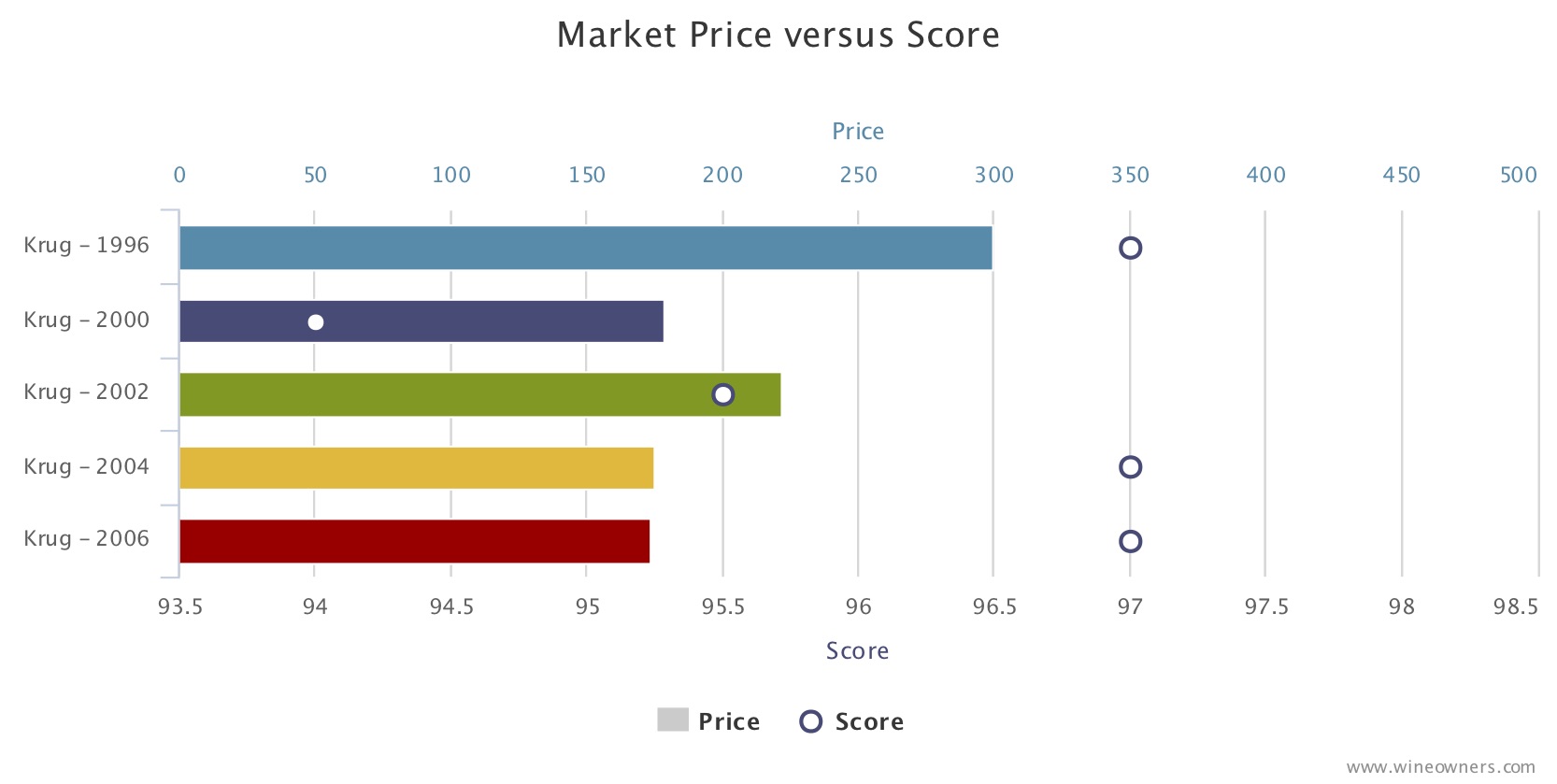
And now the relative value score:
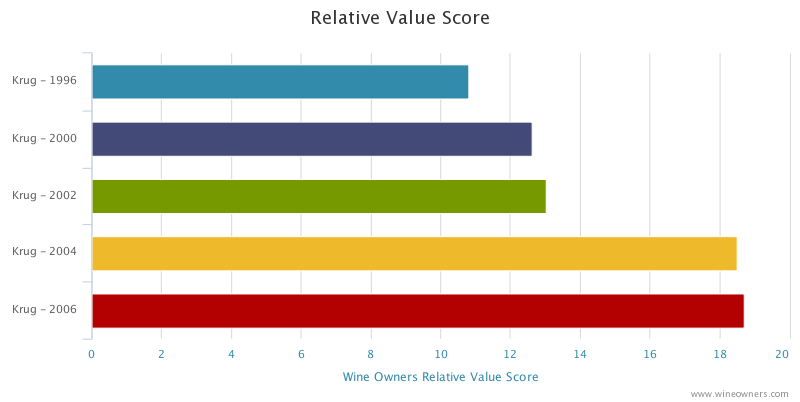
The mega vintage that is 2008 has not yet been released, so in the meantime I have no hesitation in recommending both the ’04 and the ’06 as very solid buys for the long term.
Banner Image: www.krug.com/the-house-krug
by Wine Owners
Posted on 2020-06-04
Chevalier is out this morning at £247 per 6, a perennial favourite and on the back of a seemingly great success in 2018. Hopefully in 2019 they’ll have tamed the merlot alcohols which hit 15 degrees in 2018. Bordeaux being blends saved the day and early pickings of Cabernet brought the assemblage down to under 14 degrees. Still, that kind of inherent excessiveness does make you wonder. Chevalier does age with unusually consistent grace no matter the kind of vintage.
Relative value analysis points to 2014 as being a rather decent pick of an excellent run of recent vintages. 2019 is fairly priced for collectors of this lovely estate but not to attract the short term profiteers.
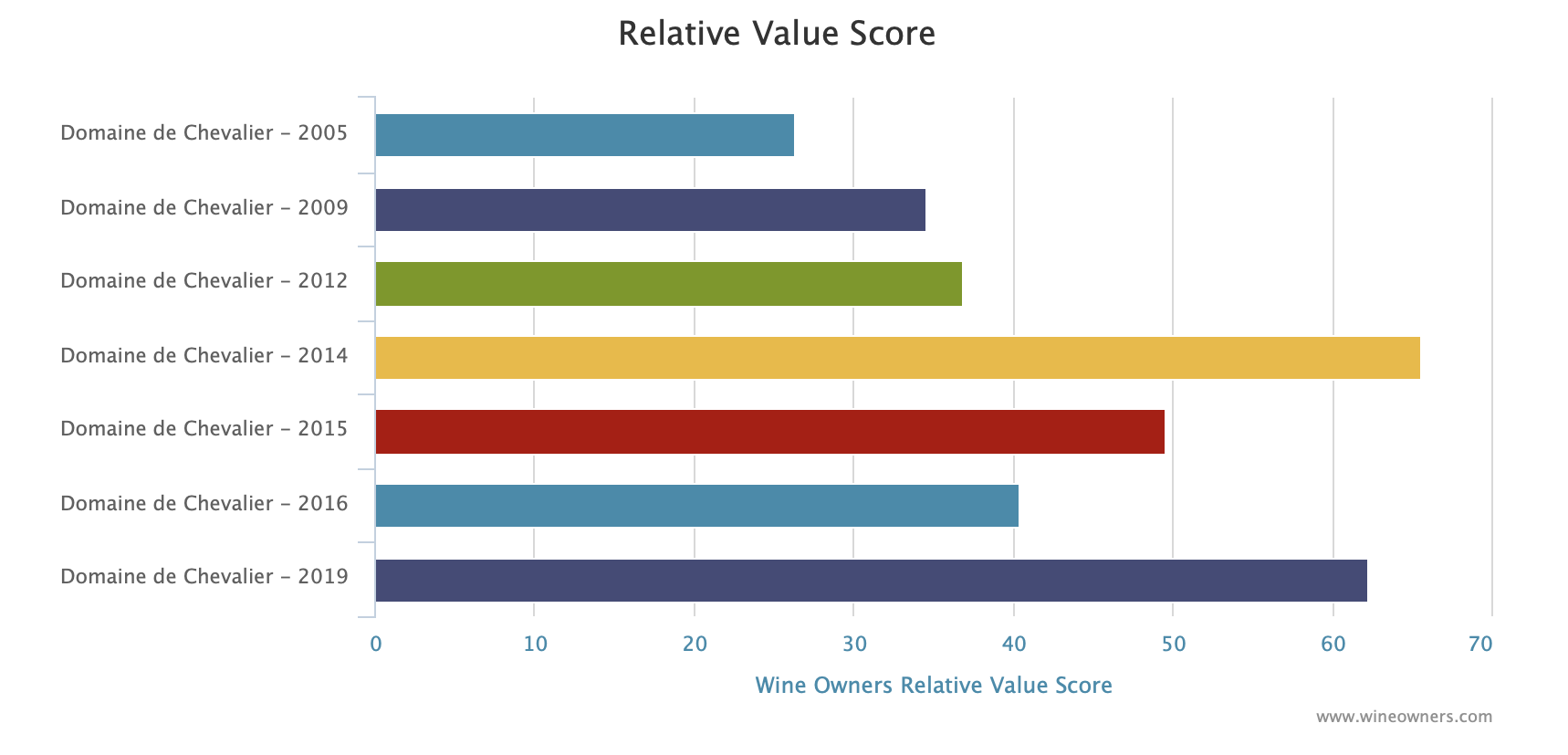
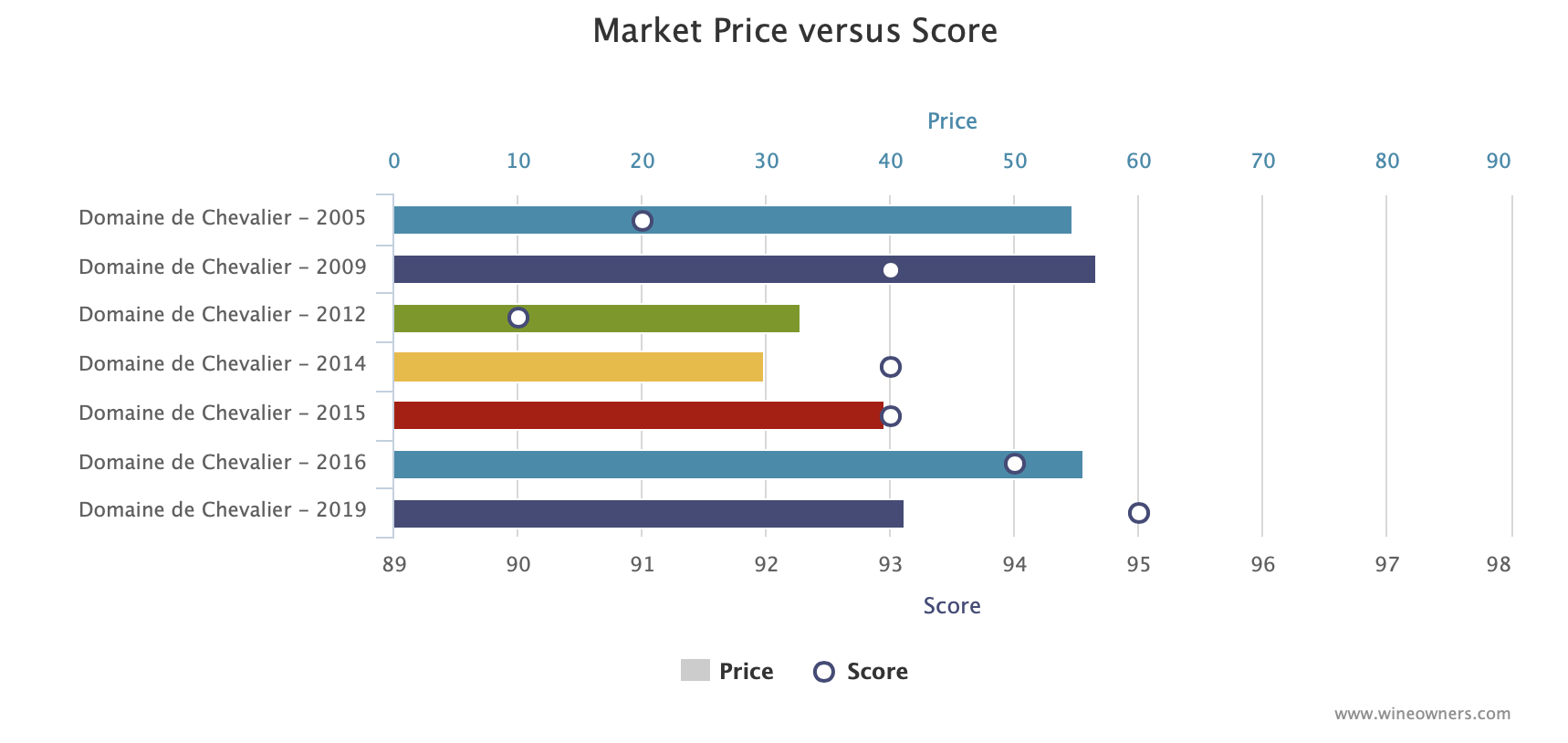
Banner Image: http://www.domainedechevalier.com
by Wine Owners
Posted on 2020-06-03
Cos d’Estournel is out £684 per 6. -23% down on 2018. Great wine they say but is the price reduction enough?
The magisterial 2016 is hovering 10% above this release price, which is among the greatest young Bordeaux Lisa Perotti-Brown has ever tasted, it’s in bottle and widely available, so we think they needed to do a little more to make this really attractive. However good the 2019 proves to be, it does not prompt the same compulsion to buy this year as Pontet Canet and Palmer.
Prices and points (we have allocated 98 points)
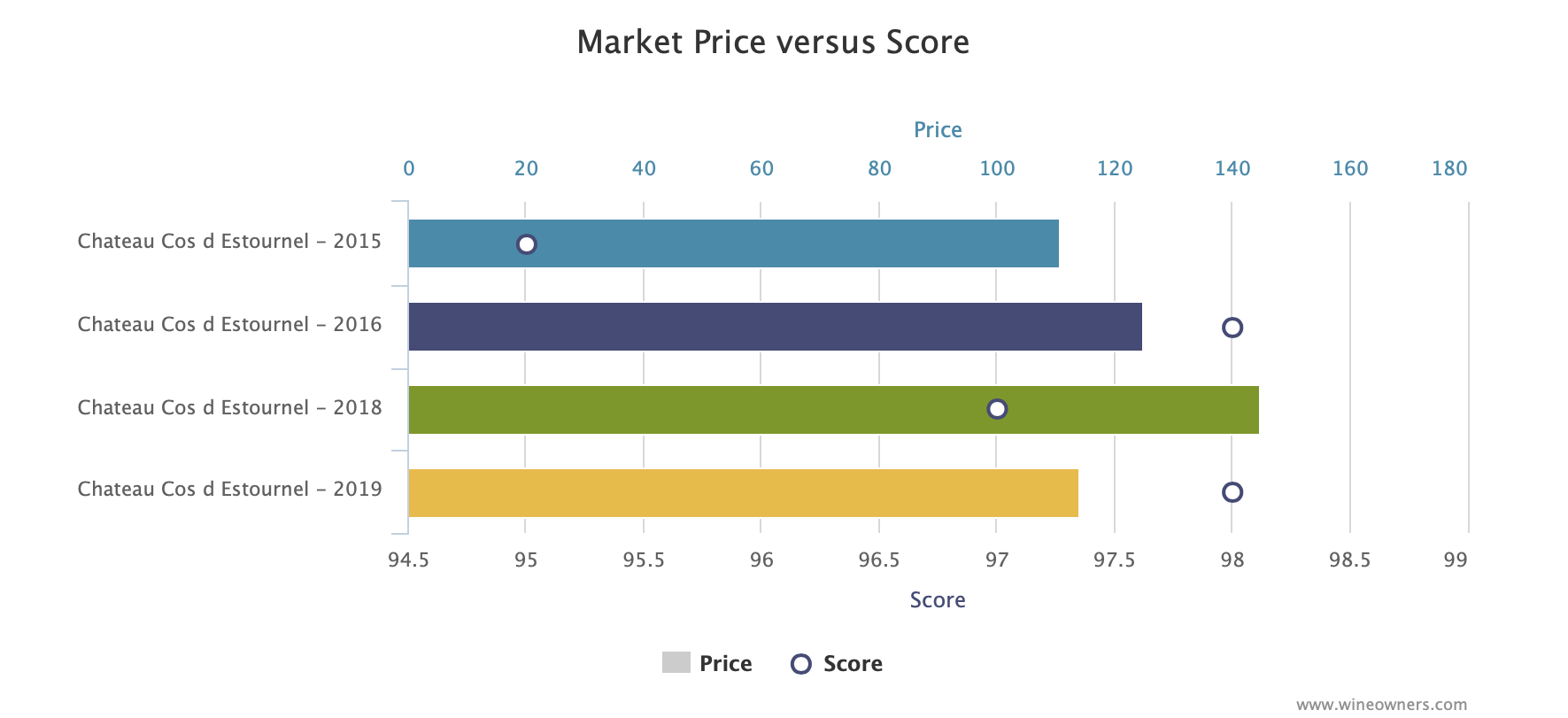
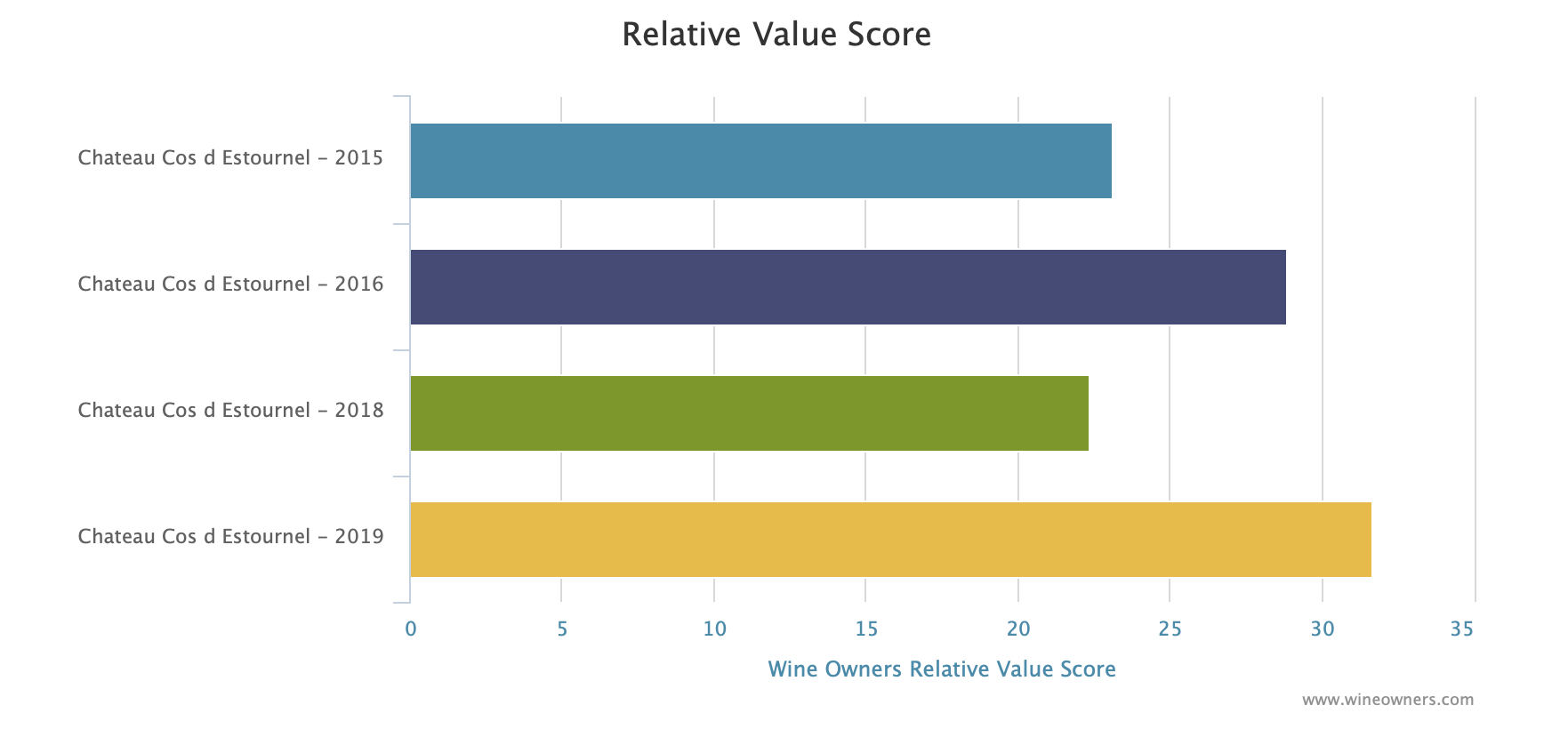
Banner Image: www.estournel.com
by Wine Owners
Posted on 2020-06-02
Palmer was released this morning at £999 per 6, a 31% reduction from the (pumped-up) pricing levels of 2016 and 2018. We are back into rational release pricing territory.
Does it work? Absolutely. Note we have put in a placeholder of 18 points but it works at 17 points too.
At this rate, if the whole of Bordeaux rallies around the reduction level of -30% to -35% set by Pontet Canet and now Palmer (and rumoured to be the level of reduction that Lafite will apply), this’ll be the first en primeur campaign since 2014 where it would make sense to buy more broadly than the very specific, narrow range that we’ve suggested makes any sense at all in the last 3 campaigns.
Here’s the analysis of Palmer.
First pricing and scores:
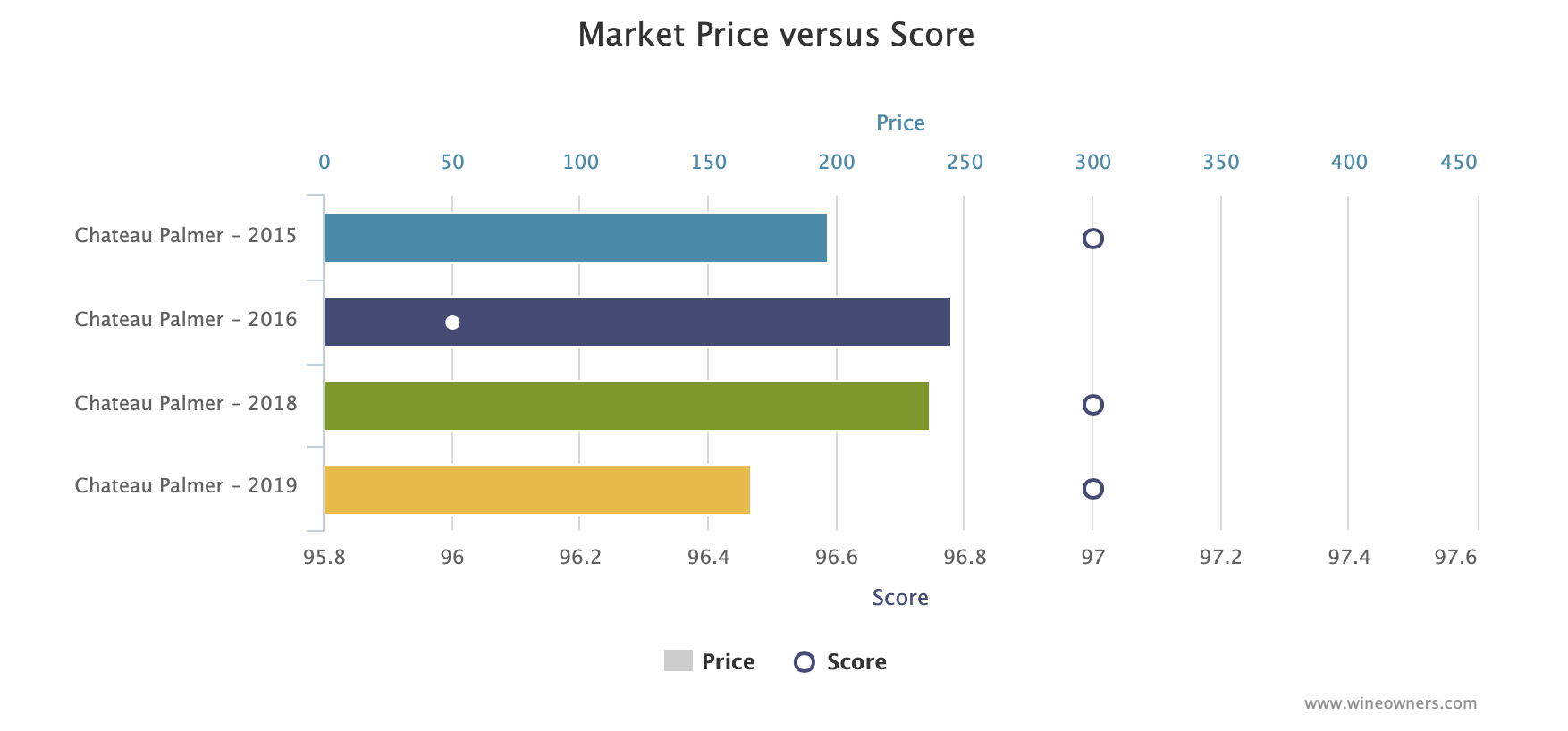
And the relative value calculation. Note how much longer, and therefore better value, the 2019 bar is than any of the comparative vintages used for the analysis:
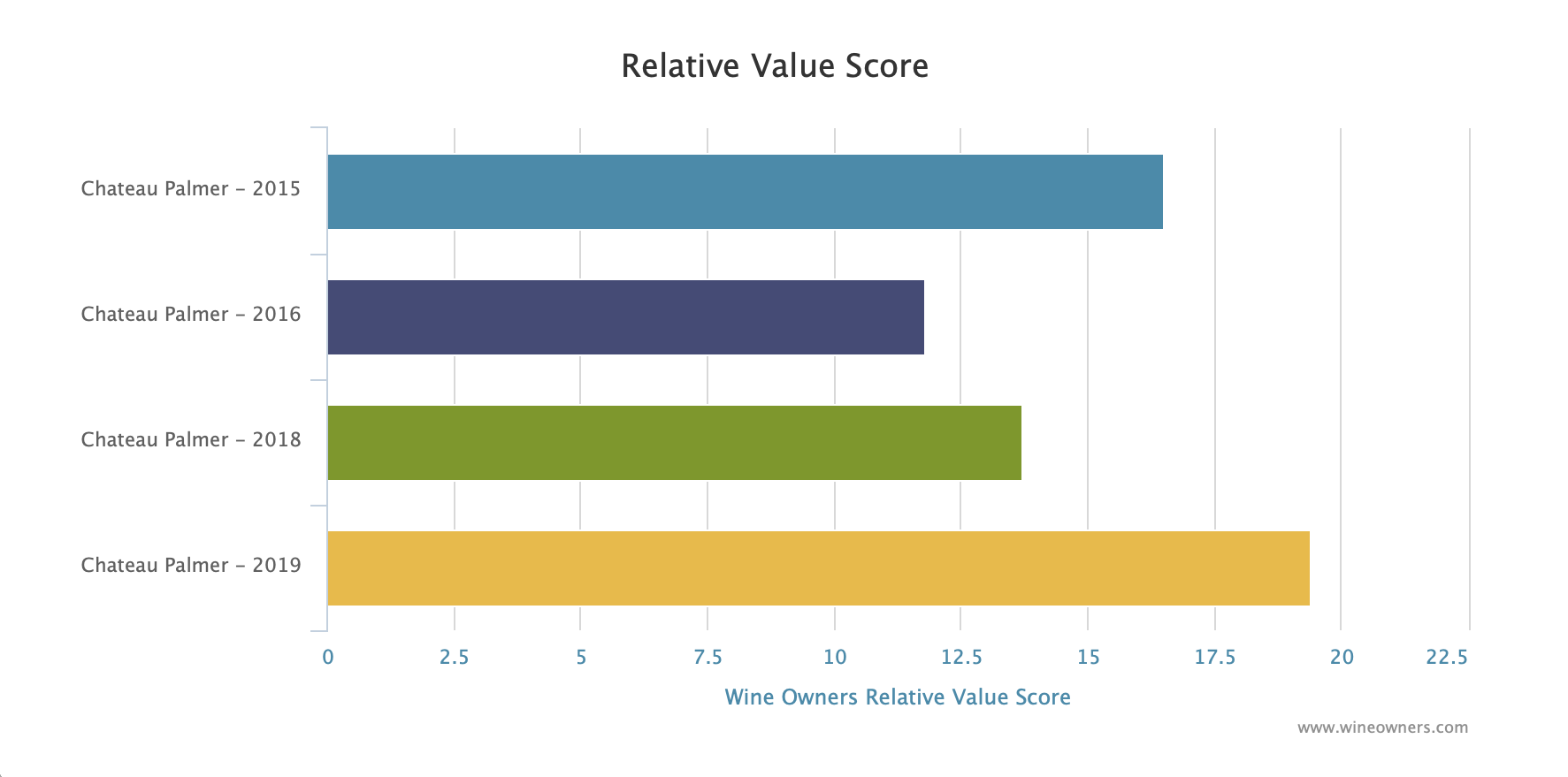
Banner Image: www.chateau-palmer.com
by Wine Owners
Posted on 2020-05-27
So Latour 2012 is out today at £350 a bottle. What’s that got to do with 2019 EP I hear you ask? Well coming as it does just before the releases of the 2019 big boys, and because it’s the first release from Latour that wasn’t previously released EP, it’s seen as a test of the market and what the consumer’s appetite is for laying out hard earned spondoolies in The Time of Covid.
I’ve seen emails from merchants this morning gushing that this is the cheapest Latour in the market today, and how they’ve got the pricing right.
The retail channel needs to see the 2019 releases come out minus 30% v 2018. That would put Lafite et al at around £2,000/ 6 and at that price it would sell. Plus it might just re-energise the Bordeaux secondary market with a dollop of positive sentiment.
However If we compare 2012 Latour to other comparable vintages of Latour, so say 2008, 2006 and 2004, which I think is rather realistic, we see a very different picture.
Here’s the market price and JR points plotted for 2012 and those benchmark vintages selected:
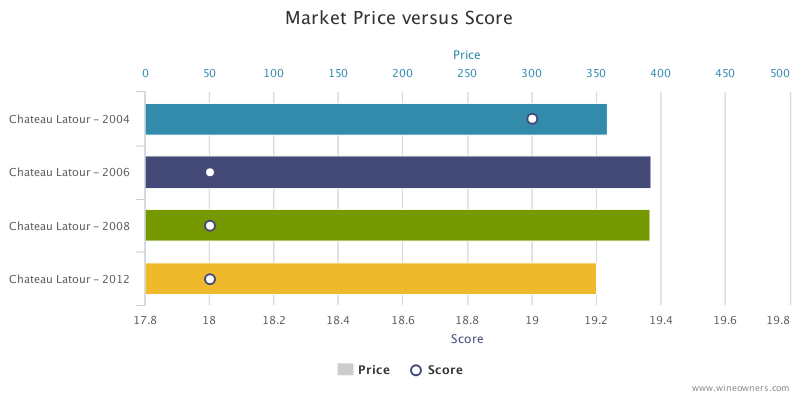
And here’s the weighted effect of that taking into account scores:
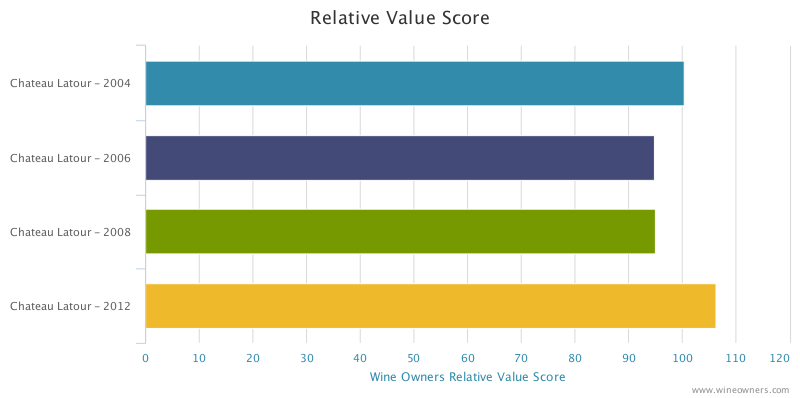
The longer the bar the better the value, the bigger the gap between the longest and the next, the more compelling the buy. Not much in it is there? Which says that Ch. Latour, far from doing their 2019 EP peers a massive favour, have given absolutely nothing away. There’s no Covid discount baked into this price. The best you can say is that there’s no guff about ex Chateau premium.
So, as a curtain raiser, it's a damp squib. But that’s their release model now and who’s to say they are wrong? At least we know what we’re drinking. The reply to this question, answerable only by Lafite et al, will come soon enough.

